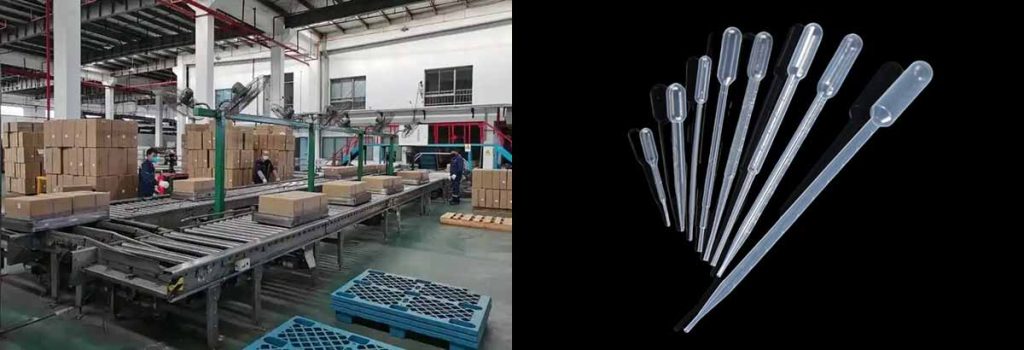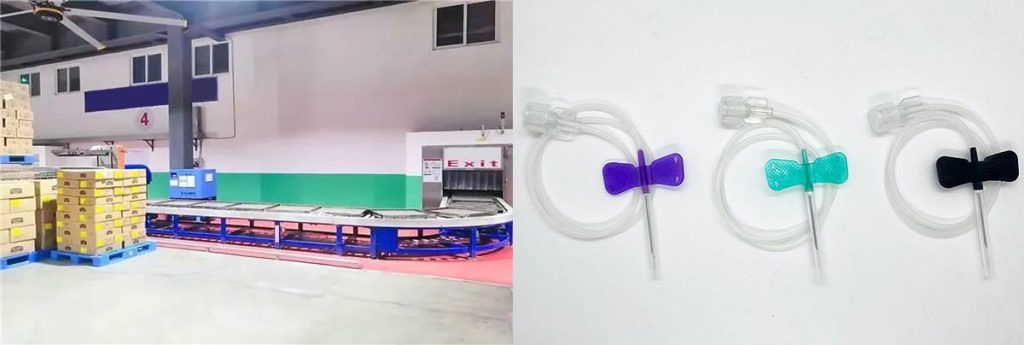

Yes, sealed foil pouch products can undergo e-beam sterilization, provided certain conditions exist. Electron beam sterilization uses high-energy electrons to target microorganisms, making it suitable for sealed packaging. This process delivers rapid microbial reduction and maintains product integrity. E-beam sterilization effectively inactivates vegetative bacteria and yeasts, though higher doses are needed for spore-forming bacteria. The method preserves the functionality of sensitive devices, offering advantages in speed and effectiveness. Understanding process speed, effectiveness, and packaging compatibility remains essential for optimal results.
Key Takeaways
- E-beam sterilization effectively inactivates microbes in sealed foil pouches, ensuring product safety and integrity.
- The process is fast, allowing for sterilization in seconds to minutes, making it ideal for high-volume production.
- Choosing the right packaging materials is crucial; thicker materials may block radiation, reducing effectiveness.
- Validation studies are essential to determine the correct irradiation dose, ensuring both safety and product quality.
- E-beam sterilization leaves no residues, making it a safe option for food and medical packaging.
E-Beam Sterilization Process
How E-Beam Works?
E-beam sterilization uses high-energy beta particles to inactivate microbes. The process relies on low energy electron irradiation, which delivers a controlled dose of radiation to the product. This method stands out for its speed and high capacity. The table below compares e-beam sterilization with gamma radiation:
| Method | Process Speed | Capacity |
|---|---|---|
| E-beam Sterilization | Seconds to minutes | Higher dosage rates |
| Gamma Radiation | Hours to tens of hours | Slower processing times |
E-beam systems use advanced electronics to control the irradiation cycle. The short exposure time reduces the risk of product degradation. Low energy electron irradiation also allows precise targeting, which helps maintain the integrity of sensitive packaging and products.
Application to Foil Pouches
Manufacturers apply e-beam sterilization to sealed foil pouch products by exposing them to a specific dose of irradiation. The sterilization process often uses a standard dose of 25 kGy, but the actual dose depends on the product’s bioburden and packaging. The steps for determining the correct dose include:
- Establishing the minimum sterilization dose for the product.
- Determining the maximum acceptable dose for flexibility.
- Auditing the sterilization dose before production and at regular intervals.
- Performing qualification studies at the e-beam facility.
Compliance with standards such as ANSI/AAMI/ISO 11137-1:2006 ensures safety and effectiveness. Low energy electron irradiation can penetrate foil pouches, making it suitable for products that require sealed packaging. Chevron seal peel pouches, which use high barrier foil laminates, allow for effective sterilization while protecting the contents.
Typical Uses
E-beam sterilization is common for a wide range of products. The table below lists typical product categories and examples:
| Product Category | Examples of Products |
|---|---|
| Moisture Sensitive Devices | Bulk Tablets |
| Tissue Products | Collagen Implants |
| Coated Products | Drug Coated Stents |
| Bulk Pharmaceuticals | Highly Sensitive Active Ingredients |
Medical devices and pharmaceuticals benefit from this process because it allows sterilization in final packaging. This approach streamlines shipping and reduces costs. E-beam irradiation is also effective for low to medium density products, ensuring safety and efficacy. The process is monitored by advanced electronics, which provides precise control and consistent results.
Sterilization Considerations
Penetration and Dose Control
Controlling the penetration of radiation through foil and product layers is essential for effective electron beam sterilization. The process relies on the ability of high-energy electrons to reach and inactivate microbes throughout the packaged products. Several factors influence how well the radiation penetrates the packaging and the contents inside. The table below summarizes these key factors:
| Factor | Description |
|---|---|
| Material Density | High-density materials absorb more energy, reducing the effectiveness of e-beam penetration. |
| Size | The size of the material affects how well it responds to e-beam irradiation. |
| Melting Point | High melting points can lead to localized heating, affecting structural integrity during irradiation. |
| Chemical Stability | Unstable materials may undergo significant chemical changes when exposed to e-beam irradiation. |
Operators must select the correct dose to ensure the process inactivates microbes without damaging the product. Too low a dose may leave some microbes alive, while too high a dose can harm the product or packaging. Dose mapping and validation studies help determine the optimal settings for each type of packaging and product. Electron beam sterilization offers precise control over dose delivery, which supports both safety and effectiveness.
Packaging and Material Compatibility

The choice of packaging materials and their thickness plays a major role in the success of the sterilization process. Flexible sterile barrier packaging, such as chevron seal peel pouches made from foil laminates, provides a strong barrier against contamination. However, the thickness and composition of these materials can affect how much radiation reaches the product inside.
Manufacturers must consider the following when selecting packaging for electron beam sterilization:
- Thicker or denser materials may block or absorb more radiation, reducing the effectiveness of the process.
- Some materials, like Tyvek combined with aluminum foil, have shown excellent compatibility, extending shelf life and maintaining sterility for several years.
- The process works best with low to medium density products and packaging that allows sufficient penetration of the electron beam.
A well-chosen packaging system ensures that the process sterilizes the entire product without compromising the barrier properties. This compatibility is especially important for medical devices and pharmaceuticals, where maintaining sterility and product quality is critical.
Product Integrity
Maintaining the physical integrity of products after irradiation is a top priority. Studies have examined how electron beam sterilization affects both the packaging and the products inside sealed foil pouches. For example, research on PTFE (a common polymer) found that the reduction in yield stress was much lower in oxygen-free foil pouches than in breathable pouches, even at higher radiation doses. The table below highlights these findings:
| Study Focus | Packaging Environment | Radiation Dose | Yield Stress Reduction |
|---|---|---|---|
| Effects of E-beam Sterilization on PTFE | Aerial (breathable pouches) | 15, 35, 60 kGy | 35% to 90% reduction |
| Effects of E-beam Sterilization on PTFE | Oxygen-free (foil pouches) | Up to 46 kGy | 10% reduction at 60 kGy |
This evidence shows that sealed foil pouches can protect products from excessive physical changes during the process. In addition, electron beam sterilization has proven effective in extending the shelf life of packaged products. For instance, Tyvek and aluminum foil combinations dramatically extend shelf life and maintain sterility over time. In food applications, e-beam irradiation reduces bacterial counts and enhances safety, which leads to longer-lasting products.
Tip: Always validate the process for each product and packaging combination to ensure both effectiveness and product quality.
By considering penetration, material compatibility, and product integrity, manufacturers can achieve reliable sterilization results. Electron beam sterilization stands out among radiation sterilization modalities for its speed, precision, and ability to work with a variety of flexible sterile barrier packaging systems.
Advantages and Limitations
Benefits of E-Beam
Electron beam sterilization offers several advantages for sealed foil pouch products. The process stands out for its rapid processing time, which allows manufacturers to sterilize large volumes in minutes or even seconds. This speed makes e-beam ideal for high-volume production environments. The process also supports cost-effectiveness, especially for large-scale operations, because it reduces dependency on radioactive materials and lowers per-unit costs. Quick irradiation minimizes changes to product properties, helping to preserve quality and nutritional value. E-beam leaves no residues, making it suitable for food and medical packaging. The table below summarizes these benefits:
| Advantage | Description |
|---|---|
| Rapid Processing Time | E-beam sterilization has the shortest process cycle, allowing products to be sterilized quickly. |
| Cost-Effectiveness | Operating e-beam systems is more economical due to reduced dependency on radioactive materials. |
| Quality Retention | Quick exposure minimizes changes to product properties, preserving quality and nutritional value. |
| No Residues | E-beam leaves no residues, making it suitable for food packaging materials. |
Drawbacks and Challenges
Despite its strengths, electron beam sterilization has some limitations. The process has limited penetration depth, so it works best with low to medium density products and packaging. Electrons lose energy quickly, which reduces effectiveness in thicker materials. Some sensitive materials may degrade under radiation, so upfront testing is necessary. Operators must monitor effects on material attributes, conduct aging studies, and evaluate seal integrity after irradiation. The table below highlights material compatibility:
| Material Type | Compatibility with E-beam Sterilization | Risk of Degradation |
|---|---|---|
| Plastic (PET, PE, PP) | High | Minimal |
| Metallic Foil | High | Minimal |
| Non-vented Packaging | High | Minimal |
Note: E-beam is not suitable for high-density materials or large dimensions that cannot be subdivided efficiently.
When to Use E-Beam?
E-beam sterilization is preferred when rapid processing is necessary or when products require minimal changes to packaging or contents. The process works well for medical devices, pharmaceuticals, and food items in foil pouches. E-beam has fewer effects on plastic materials compared to other radiation sterilization modalities like gamma. It also offers a cleaner environmental profile, as it does not rely on hazardous substances. Manufacturers should consider e-beam when a snug fit around the product is important to minimize air during irradiation and when high throughput is required.
Conclusion

Electron beam sterilization can effectively treat sealed foil pouch products when manufacturers meet key conditions. The table below highlights essential requirements for success:
| Key Condition | Description |
|---|---|
| Appropriate Irradiation Dose | A dose of 25 kGy achieves a Sterility Assurance Level of 10–6. |
| Dose and Temperature Control | Full control during sterilization ensures product safety. |
| Material Tolerance | Materials like PMMA tolerate a single sterilization dose. |
Manufacturers should evaluate packaging and product compatibility before choosing electron beam sterilization for medicinal products. Experts recommend validation studies that define minimum and maximum doses, calculate dose uniformity, and estimate process variance. Companies must follow ISO 11137 and FDA guidelines to ensure compliance and safety.
Tip: Consult with sterilization specialists and conduct thorough validation before implementation. Consider both the advantages and limitations to select the best method for your needs.
FAQ
Can Electron Beam Sterilization Damage Foil Pouch Packaging?
Electron beam sterilization rarely damages foil pouch packaging. Most foil laminates withstand the process. Manufacturers should test packaging materials before large-scale use.
What Types of Products Benefit Most from Electron Beam Sterilization?
Medical devices, pharmaceuticals, and food products packaged in sealed foil pouches benefit most. These items require rapid sterilization and minimal changes to packaging or contents.
How Does Electron Beam Sterilization Compare to Gamma Radiation?
Electron beam sterilization works faster than gamma radiation. It processes products in minutes. Gamma radiation takes hours. Electron beam sterilization suits low to medium density products and offers precise dose control.
Is Electron Beam Sterilization Safe for Food Products?
Electron beam sterilization is safe for food products. The process leaves no chemical residues. It reduces bacteria and extends shelf life. Regulatory agencies approve its use for many foods.
What Standards Govern Electron Beam Sterilization?
ANSI/AAMI/ISO 11137 and FDA guidelines govern electron beam sterilization. These standards ensure safety, effectiveness, and product quality. Manufacturers must validate processes to meet regulatory requirements.
